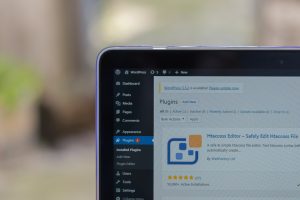It’s time to start planning for 2022, which means it’s time to get started on finding WordPress tips and best practices for making your greatest websites ever! Whether it’s making an effort to keep plugins up-to-date or considering a blog redesign around the Gutenberg editor, there are several things you can do to improve your WordPress sites in 2022!
Take your time to enhance your current websites and workflow before getting too busy with new clients or consumed with projects next year.
These are a few WordPress Tips:
- Test site updates regularly.
- Use the Gutenberg editor to update and customize a WordPress site (WordPress 5.0)
- Update the styles and plugins for your WordPress content.
- Verify that your sites are mobile-friendly.
- To each domain, install SSL certificates.
- Find the tools you enjoy using.
- Involve your clients in the design and development process.
1. Always conduct tests on a live website to ensure that the site is free of bugs and suitable for production usage.
The first recommendation on the list earned the top spot for a crucial reason: You should remember this in everything else we’re going to discuss.
Whenever one makes modifications to your site, there’s the possibility that something will go wrong, and your site will crash. Downtime is particularly important when your website is connected to your business.
2. Knowing the Gutenberg editor appropriately (WordPress 5.0)
This version of WordPress was initially launched in late 2018, bringing with it the Gutenberg editor. Each webpage has many distinct “blocks” (pages, blog entries, video clips) that may be seen by clicking on the + symbol in the top-left corner of a page.
It aids in the following ways:
- They increased the ease of use and made the content production process more intuitive and simpler for novices to grasp.
- It’s designed for those that don’t have any prior technical understanding of responsive designs, and it will show you how to enhance your content and make it more accessible.
Set up a local WordPress site using version 5.0 to test the current editor safely without affecting your main site.
If you’re a writer, create a fresh post using Gutenberg. There comes a fun feeling when one makes use of blocks. You could also get some more formatting ideas for future articles!
You may import an active site into your localized environment and then update WordPress to perform troubleshooting if you’re a developer. This will let you see how your present content acts to Gutenberg, allowing you to develop a strategy for updating the current live site.
3. Ensure your plugins and themes are updated

This WordPress advice isn’t new, but it’s so essential that it need to be included in any best practice collection. So now is the moment to check your themes and plugins for up-to-date and functionality.
It’s a pain to go through everything in your websites to change these things, but it’s critical for both website security and speed. An outdated version may have flaws that risks the site, and how much longer would it take to repair a malware-infected place? In addition, you may sell periodic updates to plugins alongside themes for your clients as a recurring service to generate regular income.
4. Check to see whether your websites are friendly to mobile.
This isn’t a new best practice, but it’s worth noting nevertheless: Your website must be mobile-friendly and fully responsive.
If your site is running on up-to-date, well-maintained WordPress themes plus plugins (as suggested in the last tip), there’s a good chance it performs admirably on smaller screens. (A big thanks to WordPress developers!)
If you’re developing a custom site design, though, you’ll have to be keen to ensure that your website is mobile-compatible. Again, if you find yourself needing to make any modifications, test them in a staging site or a local environment first. Otherwise, while you’re busy changing things on your site, visitors may get an odd
5. Every site should have its SSL certificate.

SSL certificates originally were thought to be especially significant for specific sorts of sites. Examples are eCommerce shops handling confidential client information or active bank portals that managed sensitive data. Having a SSL certificate today on your site is standard practice, even if creating a personal blog is the only task.
Google has been marking sites with no SSL certificates as “not secure” on its search results pages, which is something you may not want to appear on your website.
If you don’t have an SSL certificate, begin with your web host. SSL certificates are now provided by many hosting companies (a popular handout of managed WordPress hosts).
6. Discover the tools you love.
This is a great place to start when it comes to developing sites for clients. One of the most applicable methods to improve your workflow is to reduce the number of WordPress themes, add-ons, plugins, apps, extensions plus more that you use.
Yes, there will always be new problems to solve and unique site demands that must be met, but have a look at all of your tools. Is there any duplication? Can you reduce the number of devices you’re using?
Do you have a framework that you always use for WordPress themes? Perhaps a theme company with which you’re familiar? Or does every single site design necessitate adequate research time to find a new solution? First, you have to find your favorite tool.
7. Involve your consumers in the designing and creation process by involving them in the design and development.

There’s nothing inferior to completing a significant amount of work on a project only to discover that the client is unhappy about a critical aspect of it. So, to guarantee that everyone is always in agreement, make client comments an essential part of your process this year!
Take the time to get to know their company, what they enjoy/hate about other sites, and their yearly goals when onboarding a new customer. Using a client questionnaire might help you standardize that process so you don’t overlook anything at all in the project’s initial phase!
After the project is underway, keep in touch with your customer throughout the various phases, especially wireframes, mockups, development, and so on. If you’re creating a site using Local, you may even provide clients with a link direct to the live version on your computer.
You’ll avoid big changes down the road by getting feedback early on and keeping your clients happy!
Conclusion
These are the things we wish you knew when you first launched your WordPress website. We hope they assist get your site off to a good start in 2022! Drop us an email if you’re having trouble managing your WordPress site. We’re WordPress experts, and we enjoy assisting other WordPress users.

Want to discuss your sites mission?
If you have any questions about the ghostwriter preise service or understand if it is right for you.